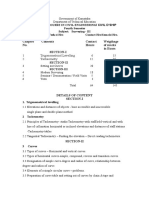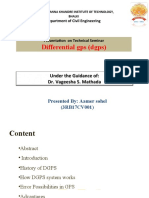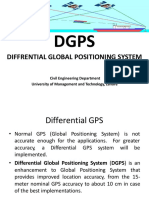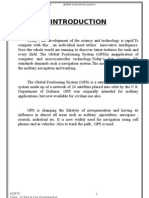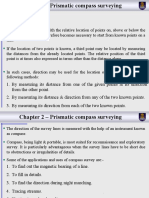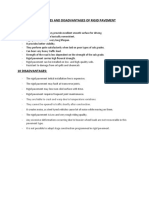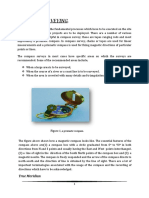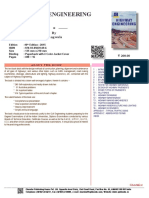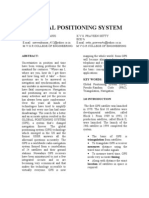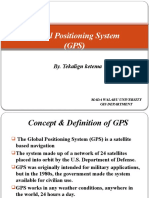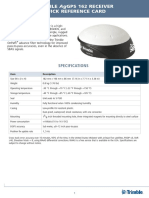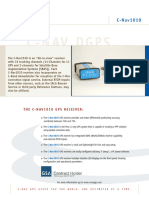Professional Documents
Culture Documents
DGPS Survey
DGPS Survey
Uploaded by
BHUSHAN KANOJOriginal Description:
Original Title
Copyright
Available Formats
Share this document
Did you find this document useful?
Is this content inappropriate?
Report this DocumentCopyright:
Available Formats
DGPS Survey
DGPS Survey
Uploaded by
BHUSHAN KANOJCopyright:
Available Formats
Differential Global Positioning System (DGPS)
CHAPTER 1
1.1 Differential GPS :-
A Differential Global Positioning System (DGPS) is an
enhancement to the Global Positioning System (GPS) which provides
improved location accuracy and integrity, in the range of operations of
each system, from the 15-meter nominal GPS accuracy to about 1-3
cm in case of the best implementations. This technique was developed in
the early 1980s, and it is widely used in various forms.
Each DGPS uses a network of fixed ground-based reference
stations to broadcast the difference between the positions indicated by
the GPS satellite system and known fixed positions. These stations
broadcast the difference between the measured satellite pseudo
ranges and actual (internally computed) pseudo ranges, and receiver
stations may correct their pseudo ranges by the same amount. The digital
correction signal is typically broadcast locally over ground-based
transmitters of shorter range.
Until 2000, civilian users had to contend with Selective
Availability (SA). The DoD intentionally introduced random timing
errors in satellite signals to limit the effectiveness of GPS and its
potential misuse by adversaries of the United States. These timing errors
could affect the accuracy of readings by as much as 100 meters.
With SA removed, a single GPS receiver from any manufacturer
can achieve accuracies of approximately 10 meters. To achieve the
accuracies needed for quality GIS records from one to two meters up to
a few centimeters requires differential correction of the data. The
majority of data collected using GPS for GIS is differentially corrected
to improve accuracy.
DGPS is a method of improving the accuracy of your receiver by
adding a local reference station to augment the information available
GURU GOBIND SINGH POLYTECHNIC, NASHIK-422009
1
Differential Global Positioning System (DGPS)
from the satellites. It also improves the integrity of the whole GPS
system by identifying certain errors.
Differential GPS uses one unit at a known location and a rover.–
The stationary unit compares its calculated GPS location with the actual
location and computes the error.–The rover data is adjusted for the error.
The underlying premise of differential GPS (DGPS) is that any two
receivers that are relatively close together will experience similar
atmospheric errors. DGPS requires that a GPS receiver be set up on a
precisely known location. This GPS receiver is the base or reference
station. The base station receiver calculates its position based on satellite
signals and compares this location to the known location.
The difference is applied to the GPS data recorded by the second
GPS receiver, which is known as the roving receiver. The corrected
information can be applied to data from the roving receiver in real time
in the field using radio signals or through post post-processing after data
capture using special processing software.
Differential correction techniques are used to enhance the quality
of location data gathered using global positioning system (GPS)
receivers. Differential correction can be applied in real Differential real
time directly in the field or when post time post-processing data in the
office. Although both methods are based on the same underlying
principles, each accesses different data sources and achieves different
levels of accuracy. Combining both methods provides flexibility during
data collection and improves data integrity. GPS is a very important data
input source. GPS is one of two (soon to be more) GNSS – Global
Navigation Satellite System.
GURU GOBIND SINGH POLYTECHNIC, NASHIK-422009
2
Differential Global Positioning System (DGPS)
Figure: 1- Differential GPS/DGPS
Examples:
a) Satellite Based Augmentation System (SBAS)
b) Wide Area Augmentation System (WAAS)
c) Local Area Augmentation System (LAAS)
d) European Geostationary Navigation Overlay Service (EGNOS)
e) Omni STAR
f) Coast guard beacon service.
GURU GOBIND SINGH POLYTECHNIC, NASHIK-422009
3
Differential Global Positioning System (DGPS)
1.2 Why do Need Differential GPS:-
By using DGPS we can improve our positional accuracy from
around 1.5m with standard GPS to around 40cm with DGPS, without the
need for post processing.
In the case of the road survey van (top right), users can measure
the amount of road wear and judge whether the road should be
resurfaced just by driving over it. Just one day’s driving can replace a
month’s manual work using traditional methods.
There are many other applications like this. The labour saving is
immense but at the same time, previously impossible tasks are made
possible such as the prediction of earthquakes before they occur.
GURU GOBIND SINGH POLYTECHNIC, NASHIK-422009
4
Differential Global Positioning System (DGPS)
1.3. Working Principle:-
The stationary receiver must be located on a known control point.
The stationary unit works backwards—instead of using timing to
calculate.
position, it uses its position to calculate timing.Can do this because
precise location of stationary receiver is known, and hence, so is
location of satellite
Once it knows error, it determines a correction factor and sends it
to the other receiver.
Message sent to rover with correction factor for all satellites.
More reference stations becoming available.
Figure 2: - Working principle of DGPS.
GURU GOBIND SINGH POLYTECHNIC, NASHIK-422009
5
Differential Global Positioning System (DGPS)
CHAPTER 2
2.1. Design Objectives of GPS:-
Suitable for different platforms: aircraft, ship, land-based and
space (missiles and satellites),
Ability to handle a wide variety of dynamics,
Real-time positioning, velocity and time determination capability
to an appropriate accuracy,
Single global geodetic datum (reference system)
for defining position,
Differential accuracy standards: highest accuracy to be restricted to
a certain class of authorized users,
Resistant to jamming (intentional and unintentional),
Redundancy provisions to ensure the survivability of the system,
Passive positioning system that does not require the transmission
of signals from the user to the satellite,
Ability to provide the service to an unlimited number of users and
world-wide coverage
Low cost, low power, therefore highly complex satellite segment,
Total replacement of the Transit 1 satellite and other terrestrial
navigation aid systems.
GURU GOBIND SINGH POLYTECHNIC, NASHIK-422009
6
Differential Global Positioning System (DGPS)
2.2. The GPS system components :-
The space segment
The control segment
The user segment.
Figure 3:- Components of GPS System.
GURU GOBIND SINGH POLYTECHNIC, NASHIK-422009
7
Differential Global Positioning System (DGPS)
2.2.1. Space segment:-
The space segment of an artificial satellite system is one of its
three operational components (the others being the user and ground
segments). It comprises the satellite or satellite constelation and the
uplink and downlink satellite links.
The overall design of the payload, satellite, ground segment, and end-
to-end system is a complex task. Satellite communications payload
design must be properly coupled with the capabilities and interaction
with the spacecraft bus that provides power, stability and environmental
support to the payload.
Basic functions of satellites include:
Receive and store information transmitted by the control
station.
Perform limited data processing by its own computer
Maintain very accurate time by means of on board 2 cesium
and 2 rubidium oscillators.
Transmit information to the user by the signal message
Maneuver to position in space controlled by the control
segment.
GURU GOBIND SINGH POLYTECHNIC, NASHIK-422009
8
Differential Global Positioning System (DGPS)
Figure 4:- GPS constellation consisting of six orbital planes with four
satellites in each plane.
2.2.2.Control Segment:-
1. Control Segment I
a) It consists of 5 tracking stations to collect data based on observing
satellite in their orbits. Tracking is executed with two frequency
receivers equipped with highly precise cesium oscillators.
b) Meteorological data is also collected for accurate evaluation of
tropospheric delay.
2. Control segment II
a) One MCS, takes data from other 5 tracking stations and
consequently predicts satellites orbits by extrapolation.
b) Computes clock correction for satellite time referred to GPS time
frame.
c) Satellite time synchronization is carried out by connecting MCS to
US Naval Observatory (USNO) in Washington DC.
d) The clock correction data is then sent to transmitting station for
uploading.
3. Control segment III
a) Three transmitting stations are involved for transmitting recent
data (including broadcast message) to satellites.
b) These stations also send telemetry commands for repositioning,
switching spare components etc.
GURU GOBIND SINGH POLYTECHNIC, NASHIK-422009
9
Differential Global Positioning System (DGPS)
2.2.3. User Segment:-
a) Consists of GPS receiver units with capability to obtain real time
positioning.
b) GPS receivers are hand-held radio-receivers/computers which
measure the time that the radio signal takes to travel from a GPS
satellite until it arrives at the GPS antenna.
c) Using the travel time multiplied by the speed of light provides a
calculation of range.
d) To each satellite in view. From this and additional information on
the satellites orbit and velocity.
e) The internal GPS receiver software calculates its position through a
process of resection.
GURU GOBIND SINGH POLYTECHNIC, NASHIK-422009
10
Differential Global Positioning System (DGPS)
Figure 5 :- Simplified GPS Receiver Block Diagram.
GURU GOBIND SINGH POLYTECHNIC, NASHIK-422009
11
Differential Global Positioning System (DGPS)
Figure 6:- The Global Positioning System
GURU GOBIND SINGH POLYTECHNIC, NASHIK-422009
12
Differential Global Positioning System (DGPS)
Figure 7: - GPS Control.
Figure 8 :- GPS Navigation.
GURU GOBIND SINGH POLYTECHNIC, NASHIK-422009
13
Differential Global Positioning System (DGPS)
CHAPTER 3
3.1. GPS Surveying Techniques:-
Static.
Fast Static.
Post-processed Kinematic.
RTK
3.1.1. Static GPS Control Surveying
Static GPS surveying has been used on control surveys from local
to statewide extent, and will probably continue to be the preferred
technique in that category. If a static GPS control survey is carefully
planned, it usually progresses smoothly. The technology has virtually
conquered two stumbling blocks that have defeated the plans of
conventional surveyors for generations. Inclement weather does not
disrupt GPS observations, and a lack of inter visibility between stations
is of no concern whatsoever, at least in post processed GPS. Still, GPS is
far from so independent of conditions in the sky and on the ground that
the process of designing a survey can now be reduced to points-per-day
formulas, as some would like. Even with falling costs, the initial
investment in GPS remains large by most surveyors’ standards.
However, there is seldom anything more expensive in a GPS project
than a surprise.
In static GPS surveying the receivers is motionless for a time,
usually a relatively long occupation. If it's planned correctly, a GPS
static survey can be independent of some of the things that have plagued
such work in the past. However, there are some things that need to be
considered—overhead obstructions, access between points, and so on
GURU GOBIND SINGH POLYTECHNIC, NASHIK-422009
14
Differential Global Positioning System (DGPS)
Figure 9:- Static GPS survey.
GURU GOBIND SINGH POLYTECHNIC, NASHIK-422009
15
Differential Global Positioning System (DGPS)
3.1.2. Rapid Static GPS Surveying :-
This is also referred to as fast-static or quick-static. The following
characteristics distinguish rapid-static techniques from other methods of
static GPS surveying:
1. Observational time requirements: these are significantly shorter
than the conventional static GPS surveying, and are a function of
baseline length, whether dual frequency instruments are used,
number of satellites being tracked and satellite geometry.
Typically the receivers need only occupy a baseline for a period of
10-30 minutes (the lower value corresponding to baseline <5 Km
and tracking six or more satellite, the upper value being for longer
baseline up to 20 Km and / or tracking is to only four satellites).
2. Hardware requirements: in most systems only dual-frequency
phase measurements are sufficient; while in other configurations
dual frequency pseudo range measurements are also required. It is
rare to mix different brands of receivers and software, compared to
static GPS surveying techniques.
3. Specialized software: the basis of this technique is the ability of
the soft ware to resolve the ambiguities using a very short
observation period. There is a variety of software, with different
characteristics and levels of sophistication’s, but the fundamental
requirement is a fast ambiguity resolution (AR) capability. Dual
frequency data is essential for fast AR.
GURU GOBIND SINGH POLYTECHNIC, NASHIK-422009
16
Differential Global Positioning System (DGPS)
Figure 10: Rapid Static GPS Survey Technique
The field procedures are much like those for conventional static GPS
surveying except:
(a) The station occupation times are shorter
(b) Baseline should be comparatively short
(c) The satellite geometry favorable
(d) Signal disturbances such as multi path should be minimum.
It is not possible to define exactly how much data needs to be
collected in order to produce quality baselines every time, that is
ambiguity fixed solutions. Equipment user manuals typically give guide
lines in this regard.
The rapid-static technique is well suited, for short range
applications such as control densification and engineering surveys or
any job where many points need to be surveyed. Unlike kinematic and
stop-and-go techniques there is no need to maintain lock on satellites
when moving from one point to another.
GURU GOBIND SINGH POLYTECHNIC, NASHIK-422009
17
Differential Global Positioning System (DGPS)
3.1.3. Post Processing :-
Post-processing is used in Differential GPS to obtain precise
positions of unknown points by relating them to known points such
as survey markers. The GPS measurements are usually stored
in computer memory in the GPS receivers, and are subsequently
transferred to a computer running the GPS post-processing software.
The software computes baselines using simultaneous measurement data
from two or more GPS receivers.
The baselines represent a three-dimensional line drawn between
the two points occupied by each pair of GPS antennas. The post-
processed measurements allow more precise positioning, because most
GPS errors affect each receiver nearly equally, and therefore can be
cancelled out in the calculations. Differential GPS measurements can
also be computed in real time by some GPS receivers if they receive a
correction signal using a separate radio receiver, for example in Real
Time Kinematic (RTK) surveying or navigation.
The improvement of GPS positioning doesn't require simultaneous
measurements of two or more receivers in any case, but can also be done
by special use of a single device. In the 1990s when even handheld
receivers were quite expensive, some methods of quasi–differential GPS
were developed, using the receiver by quick turns of positions or loops
of 3-10 survey points.
GURU GOBIND SINGH POLYTECHNIC, NASHIK-422009
18
Differential Global Positioning System (DGPS)
3.1.4. The RTK-GPS Technique:-
The RTK-GPS is an attractive technique for many survey
applications as there is no post processing of the carrier phase data. The
standard scenario requires the surveyor to operate two GPS receivers
(one reference receiver and other `roving receiver’), as well as the data
link. Once set up, the reference receiver will continuously transmit its
carrier phase measurements to the roving receiver. The software within
roving’ receiver’s microprocessor then tries to resolve the ambiguities in
shortest time possible (using OTF-AR algorithm), and resulting carrier-
range’ data is used to derive cm-level accuracy baseline results. These
results may be stored (for later down loading) displayed and used for
surveying applications or processed by a computer to guide control
machinery such as excavators etc.
Figure 11: RTK – GPS Surveying Technique.
GURU GOBIND SINGH POLYTECHNIC, NASHIK-422009
19
Differential Global Positioning System (DGPS)
Successful operation of RTK system is usually limited to baseline
lengths of 5-10Km because this is typically the inter receiver distance
over which very rapid OTF-AR algorithm work reliably. As with the
post-processed modes of carrier phase-based positioning, when signals
are obstructed then the OTF-AR algorithm has to be started again in
order to resolve the (new) ambiguities. As this may take several tens of
seconds, and if signal interruptions occur frequently, then this `dead
time’ can result in RTK being a grossly inefficient precise positioning
technique. Note that RTK need not only be used for purely kinematic
applications. RTK equipment can be used in the stop-and-go or rapid-
static mode of surveying as well, the crucial difference (and perhaps
important advantage) being that the results are available immediately
after data collection is completed.
RTK is especially vulnerable to poor satellite visibility, multi path
and unreliable data link from reference station. This link is invariably a
VHF or UHF wireless connection between reference and rover
receivers. Unfortunately the data link tends to be less robust than, for
example, data links to commercial DGPS procedures. The reasons
typically are low power of signal, interference by other transmissions,
and signal obstructions. Although proprietary data transmission formats
are the norm for RTK operations, the RTCM format does provide
message type that can be used for RTK.
GURU GOBIND SINGH POLYTECHNIC, NASHIK-422009
20
Differential Global Positioning System (DGPS)
CHAPTER 4
4.1. GPS Errors:-
Noise.
Biases.
Blunder.
Clock.
4.1.1 Noise:-
Noise errors are the combined effect of code Noise errors are the
combined effect of code noise (around 1 meter) and noise within the
noise (around 1 meter) and noise within the receiver (around 1 meter).
4.1.2. Biases Error:-
1.Selective Availability (SA):-
SA is the intentional degradation of the SPS signals by a time
varying bias. SA is controlled by the DOD to limit accuracy for non the
DOD to limit accuracy for non- U. S. military and government users.
Selective availability is turned off.
2. Ephemeris data errors: 1 meter
Satellite orbits are constantly changing. Any error in satellite
position will result in an error for the receiver position. SV clock errors
uncorrected by Control can result in one meter error. 3.Tropospheric
delays: 1 meter.
The troposphere is the lower part (ground level to from 8 to 13
km) of the atmosphere that experiences the changes in temperature,
pressure, and humidity associated with weather changes. Complex
models of tropospheric delay require estimates or measurements of these
parameters.
GURU GOBIND SINGH POLYTECHNIC, NASHIK-422009
21
Differential Global Positioning System (DGPS)
4.Unmodeled ionosphere delays: 10 meters.
The ionosphere is the layer of the atmosphere from 50 to 500 km that
consists of ionized air. The transmitted model can only remove about
half of the possible 70 ns of delay leaving a ten meter unmodeled
residual.
5.Multipath: 0.5 meters.
Multipath is caused by reflected signals from surfaces near the
receiver that can either interfere with or be mistaken for the signal that
follows the straight line path from the satellite.
4.1.3 Blunders :-
Blunders can result in errors of hundreds of kilometers. Control
segment mistakes due to computer or human error can cause errors from
one meter to hundreds of kilometers. User mistakes, including incorrect
geodetic User mistakes, including incorrect geodetic datum selection,
can cause errors from 1 to hundreds of meters. Receiver errors from
software or hardware failures can cause blunder errors of any size.
4.1.Errors addressed by DGPS:-
clock errors,
path errors,
ephemeris errors
ionospheric effects
GURU GOBIND SINGH POLYTECHNIC, NASHIK-422009
22
Differential Global Positioning System (DGPS)
CHAPTER 5
5.1.Advantages of GPS :-
Unlike conventional surveying procedures, there is no need for
intervisibility between stations.
Independent of weather conditions as a result of using radio
frequencies to transmit the signals.
Use of same field and data reduction procedures results in position
accuracy which
independent of network
shape or geometry and are primarily a function of inter-station
distance.
GPS surveying provides generally homogeneous accuracy. Hence,
geodetic network planning in the classical sense is
longer relevant. The points can be established wherever they are
required
need not be located at evenly distributed sites
atop mountains to satisfy intervisibility, or network geometry
criteria.
GPS surveying is more efficient, more flexible and less time
consuming positioning
technique than using conventional terrestrial survey technologies.
GPS can be used to obtain high accuracy three dimensional (3D)
information, anywhere and
time with relatively little effort on a global datum .
The GPS instrumentation and the data processing software do not
radically
even if very high or moderately high accuracies are required (from
1 part in 104 to 1 part in 106 ).
GURU GOBIND SINGH POLYTECHNIC, NASHIK-422009
23
Differential Global Positioning System (DGPS)
CHAPTER 6
6.1.Applications:-
Natural resources
Precision farming
Civil Engineering applications
Structural deformations
Open pit mining
Land and marine seismic surveying
Airborne mapping
Seafloor mapping
Vehicle navigation
Transit system
Retail industry
Cadastral surveying
Stakeout (waypoint navigation)
Location based services (LBS)
GURU GOBIND SINGH POLYTECHNIC, NASHIK-422009
24
Differential Global Positioning System (DGPS)
CHAPTER 7
7.1 References
1. "SAPOS-Dienste im Überblick" (in German). Retrieved April
16, 2019.
2. ^ "US Government page on GPS augmentation systems". Gps.gov.
2012-03-14. Retrieved 2013-07-07.
3. ^ Kee, C., Parkinson, B. W., and Axelrad, P. (1991), "Wide area
differential GPS", Navigation, Journal of the Institute of
Navigation, 38, 2 (Summer, 1991),
<https://www.ion.org/publications/abstract.cfm?articleID=100207
4. ^ McNamara, Joel (2008), GPS for Dummies (2nd ed.), ISBN 978-
0-470-15623-0
5. ^ Ho, Angela; Mozdzanowski, Alex; Ng, Christine (2005), GPS
Case (PDF), Open Courseware, MIT, page 11.
6. ^ "USCG DGPS coverage plot via USCG Navigation Center".
Retrieved 2013-07-07.
7. ^ GPS for Dummies, stating that there weren't enough military
GPS receivers, so "Selective Availability was temporarily turned
off in 1990 during the Persian Gulf War" so that Coalition troops
could use civilian GPS receivers
GURU GOBIND SINGH POLYTECHNIC, NASHIK-422009
25
You might also like
- Man User DPS232Document110 pagesMan User DPS232Douglas BemficaNo ratings yet
- Guideline For Location and Design of Bus StopDocument37 pagesGuideline For Location and Design of Bus StopAmul ShresthaNo ratings yet
- Total StationDocument14 pagesTotal StationGayathri Manjunath Shepur50% (2)
- Total Station and Its ApplicationsDocument10 pagesTotal Station and Its ApplicationskorbelNo ratings yet
- Railway Engineering 2 TractionDocument21 pagesRailway Engineering 2 Tractionraghav Varma100% (1)
- Surveying IIIDocument7 pagesSurveying IIIShaik Jhoir100% (1)
- MSA Processor Operation ManualDocument44 pagesMSA Processor Operation Manualupesddn2010No ratings yet
- Differential Gps (DGPS) : Under The Guidance Of: Dr. Vageesha S. MathadaDocument21 pagesDifferential Gps (DGPS) : Under The Guidance Of: Dr. Vageesha S. MathadaShaik Zeeshan100% (1)
- GPS Notes PDFDocument13 pagesGPS Notes PDFAlok100% (1)
- Chapter 1 - Differential GPS: RTO-AG-160-V21 1 - 1Document18 pagesChapter 1 - Differential GPS: RTO-AG-160-V21 1 - 1ravifireblade8402No ratings yet
- Differential Global Positioning System: Marri Laxman Reddy Institute of Technology and ManagementDocument26 pagesDifferential Global Positioning System: Marri Laxman Reddy Institute of Technology and ManagementSanjana PulapaNo ratings yet
- DGPS Surveying InstrumentDocument5 pagesDGPS Surveying InstrumentAnkit kumat100% (1)
- 5Document20 pages5Ayesha ImranNo ratings yet
- DGPSDocument31 pagesDGPSWebster Vaz100% (3)
- Surveying II Lab ManualDocument76 pagesSurveying II Lab ManualKRISHNA VAMSI100% (1)
- Chapter 6 - Introduction To Advanced SurveyDocument34 pagesChapter 6 - Introduction To Advanced Surveydixn__100% (2)
- Seminar Global Positioning System MainDocument24 pagesSeminar Global Positioning System Maindevilsajeer80% (5)
- Modern Survey Unit-4Document61 pagesModern Survey Unit-4KIRAN KUMAR100% (2)
- Theodolite and TS Survey LectureDocument15 pagesTheodolite and TS Survey LectureJoseph ZotooNo ratings yet
- Chain SurveyingDocument24 pagesChain SurveyingSherly JamesNo ratings yet
- Chapter 2 - Prismatic Compass SurveyingDocument32 pagesChapter 2 - Prismatic Compass Surveyingamin100% (3)
- Total StationDocument13 pagesTotal StationEr Santosh Kapar100% (1)
- Traffic Design and Visual AidsDocument40 pagesTraffic Design and Visual AidsPrakash SamshiNo ratings yet
- Advantages and Disadvantages of Rigid PavementDocument1 pageAdvantages and Disadvantages of Rigid PavementGelo Dizon100% (1)
- Geometric Design of Railways TracksDocument21 pagesGeometric Design of Railways TracksJACOB CHIMIDZINo ratings yet
- Pavement EvaluationDocument12 pagesPavement Evaluationsreejithp10433% (3)
- Railway Visit ReportDocument14 pagesRailway Visit ReportParth AnajwalaNo ratings yet
- COMPASS SURVEYING Class NotesDocument7 pagesCOMPASS SURVEYING Class NotespreciousNo ratings yet
- Sedimentation AnalysisDocument2 pagesSedimentation AnalysisArvin Bhurtun100% (1)
- Theodolite SurveyingDocument38 pagesTheodolite SurveyingNihal Bin MuhammedNo ratings yet
- Survey in RailwayDocument21 pagesSurvey in RailwayManish Kumar Gupta100% (1)
- Functional Condition Evaluation of PavementsDocument17 pagesFunctional Condition Evaluation of Pavementsbilzinet100% (2)
- Factors Theoretically Influence The Choice of The GaugeDocument3 pagesFactors Theoretically Influence The Choice of The GaugenouriNo ratings yet
- Cross Sectional Elements of A RoadDocument16 pagesCross Sectional Elements of A RoadRamanarayanSankritiNo ratings yet
- Traversing Notes - Surveying II - Sudip Khadka - CivilengineeringDocument37 pagesTraversing Notes - Surveying II - Sudip Khadka - CivilengineeringSudip KhadkaNo ratings yet
- Introduction To The GPSDocument31 pagesIntroduction To The GPSarjunr1991100% (3)
- Adaptive Autopilot For Marine VesselsDocument6 pagesAdaptive Autopilot For Marine VesselsGAMMA FACULTYNo ratings yet
- Compaction PilesDocument11 pagesCompaction PilesJuhili SawantNo ratings yet
- Railway Station and YardsDocument35 pagesRailway Station and YardsManish kumarNo ratings yet
- Highway Engineering: by RangwalaDocument3 pagesHighway Engineering: by RangwalaJATINKUMAR CHAUDHARINo ratings yet
- Ground Improvement Techniques ME 3rd Sem PPT FileDocument57 pagesGround Improvement Techniques ME 3rd Sem PPT FileArham Sheikh100% (6)
- Surveying Lab ManualDocument77 pagesSurveying Lab ManualAtish Kumar88% (8)
- Canal Maintenance & OperationDocument22 pagesCanal Maintenance & OperationDevendra Sharma100% (2)
- Applications of Gps and Gis in Civil EngineeringDocument19 pagesApplications of Gps and Gis in Civil EngineeringVishal Patel33% (3)
- What Is A Total StationDocument13 pagesWhat Is A Total StationEr Santosh KaparNo ratings yet
- Highway AlignmentDocument15 pagesHighway AlignmentPadmarekha A100% (2)
- HW-I CH2 Highway Route Surveys and LocationaaDocument29 pagesHW-I CH2 Highway Route Surveys and LocationaaYUlian TarikuNo ratings yet
- GIS Geographical Information SystemDocument45 pagesGIS Geographical Information SystemJames TheodoryNo ratings yet
- Priciple of Aerial Photography and TypesDocument42 pagesPriciple of Aerial Photography and TypesTOt's Vin67% (3)
- Chapter 2 & 3-GIS Data and Database Management and Prcocessing SystemsDocument39 pagesChapter 2 & 3-GIS Data and Database Management and Prcocessing SystemsDani Ftwi100% (2)
- Types of Tube Wells & Its ConstructionDocument51 pagesTypes of Tube Wells & Its Constructionrbroy_dwsd88% (8)
- Chapter One PPT of GeodesyDocument31 pagesChapter One PPT of GeodesyGemechu Kotola100% (3)
- Report Final SalllDocument88 pagesReport Final Salllnurhazli ibrahimNo ratings yet
- Satellite Navigation (GPS)Document28 pagesSatellite Navigation (GPS)NAJA MOHAMEDNo ratings yet
- Differential GPS ExplainedDocument5 pagesDifferential GPS Explained87291472BG100% (2)
- 1-Differential GPS ExplainedDocument5 pages1-Differential GPS ExplainedGanga BasinNo ratings yet
- Real-Time Kinematic Positioning With NASA's Internet-Based Global Differential GPS (IGDG)Document10 pagesReal-Time Kinematic Positioning With NASA's Internet-Based Global Differential GPS (IGDG)Hammam AbdurrahmanNo ratings yet
- Global Positioning SystemDocument6 pagesGlobal Positioning SystemAlyssa Alexis RamosNo ratings yet
- Differential Global Positioning System: Marri Laxman Reddy Institute of Technology and ManagementDocument11 pagesDifferential Global Positioning System: Marri Laxman Reddy Institute of Technology and ManagementSanjana PulapaNo ratings yet
- GPS PDFDocument14 pagesGPS PDFSinu VasuNo ratings yet
- Global Positioning System: AbstractDocument7 pagesGlobal Positioning System: Abstractasjad12No ratings yet
- Global Positioning SystemDocument19 pagesGlobal Positioning SystemBlack's ContinentNo ratings yet
- Specifications: Item DescriptionDocument6 pagesSpecifications: Item DescriptiongeraldoNo ratings yet
- Nautical Institute DP Webinar 03 Dec 2020 SlidesDocument29 pagesNautical Institute DP Webinar 03 Dec 2020 SlidesDarwin PonteNo ratings yet
- GNSS Question BankDocument3 pagesGNSS Question Bankpavankumar789087No ratings yet
- The Acronym "GPS": GPS, Department of Defense NAVSTAR GPS United State System Global Navigation Satellite System (GNSS)Document48 pagesThe Acronym "GPS": GPS, Department of Defense NAVSTAR GPS United State System Global Navigation Satellite System (GNSS)ganeshNo ratings yet
- Performance Analysis of Different Positioning Modes in RTKLIB SoftwareDocument12 pagesPerformance Analysis of Different Positioning Modes in RTKLIB Softwarehani aprilianiNo ratings yet
- C-Nav GPS System Operations ManualDocument262 pagesC-Nav GPS System Operations Manual_commandos_No ratings yet
- Annual Notices To Mariners EngDocument302 pagesAnnual Notices To Mariners EngAnonymous 5dtQnfKeTqNo ratings yet
- SR520 Leica BrochureDocument10 pagesSR520 Leica Brochurejose antonio carazoNo ratings yet
- 1 DPS-100Document2 pages1 DPS-100TonyNo ratings yet
- Online DGPS Data ProcessingDocument7 pagesOnline DGPS Data ProcessingargaikwadNo ratings yet
- 03 March 1993Document116 pages03 March 1993Monitoring TimesNo ratings yet
- Man BNWAS 2.3 EngDocument262 pagesMan BNWAS 2.3 Engmilen65No ratings yet
- Func 1.3 LESSON PLAN Electronic NavDocument16 pagesFunc 1.3 LESSON PLAN Electronic Navambar kusumawatiNo ratings yet
- CNav 1010Document2 pagesCNav 1010Han SoloNo ratings yet
- Teseo Liv3flDocument34 pagesTeseo Liv3flАртем ВитальевичNo ratings yet
- Survey Tute 3CE - T3 - BCE-302 - Akhil PandeyDocument1 pageSurvey Tute 3CE - T3 - BCE-302 - Akhil Pandeyamansri035No ratings yet
- SurvCE V4 Instrument Setup Manual PDFDocument113 pagesSurvCE V4 Instrument Setup Manual PDFCadastru IntabulareNo ratings yet
- Computer Notes Section 1.1Document13 pagesComputer Notes Section 1.1MichaelNo ratings yet
- LECTURE01 UpdatedDocument101 pagesLECTURE01 Updated王和盛No ratings yet
- Casius 5.0.1.8Document42 pagesCasius 5.0.1.8johnhdatuNo ratings yet
- Differential GPS (DGPS)Document72 pagesDifferential GPS (DGPS)Clarence PieterszNo ratings yet
- GPS Presentation PDFDocument12 pagesGPS Presentation PDFDee CeeNo ratings yet
- Visual Assistance For Blind Person by Using Machine Learning TechnologyDocument23 pagesVisual Assistance For Blind Person by Using Machine Learning TechnologyCentral Asian StudiesNo ratings yet
- Gps Seminar ReportDocument13 pagesGps Seminar ReportRAJESH KAMBOJNo ratings yet
- Aggps 214: High-Accuracy ReceiverDocument12 pagesAggps 214: High-Accuracy ReceiverHayman SANo ratings yet
- Chapter 1 - 2 GNSS Positioning ModesDocument44 pagesChapter 1 - 2 GNSS Positioning ModesHawani SobryNo ratings yet
- Title: GPS: Global Positioning SystemDocument18 pagesTitle: GPS: Global Positioning SystemBa HoNo ratings yet
- NMDC Vocational Training ReportDocument34 pagesNMDC Vocational Training ReportEđđy Åadi ßãrsàNo ratings yet





